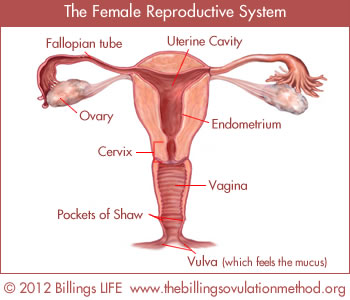We know from extensive scientific research that cervical mucus is essential for fertility. It protects and nourishes the sperm so they retain their fertilising capacity. It forms channels which help the sperm travel through your reproductive system to meet and fertilise the egg. And it acts as a filter, destroying imperfect sperm cells.
The key to understanding your fertility is what you feel at the vaginal opening, called the vulva, as you go about your normal daily activities. Sometimes during your cycle you may wonder if your period has started. You feel wetness and slipperiness at the vulva. When you check you might see a discharge, and think nothing of it. But far from being nothing, this mucus, which is produced by the cervix for a few days before ovulation, is essential for fertility. To understand this natural signal of fertility you only have to pay attention to the sensation it produces. You don't have to touch it or make an internal investigation.
 When fertility begins, you'll notice a change in sensation at the vulva which develops over the next few days. Any mucus you see is likely to become thinner and clearer, and the sensation becomes wet and then slippery. Both clinical and laboratory studies have shown that the most fertile time in the cycle coincides with what we call the Peak - the last day of the slippery sensation at the vulva. We know from hormonal studies that the Peak day relates very closely to the time of ovulation. In most cycles the egg will be released on the Peak day, but in some cycles ovulation may not occur until day 1 or day 2 past the Peak. The egg lives for a maximum of 24 hours after being released. By keeping a daily record of the sensation and appearance of the mucus you can learn to recognise your times of infertility, potential fertility and the Peak of fertility.
When fertility begins, you'll notice a change in sensation at the vulva which develops over the next few days. Any mucus you see is likely to become thinner and clearer, and the sensation becomes wet and then slippery. Both clinical and laboratory studies have shown that the most fertile time in the cycle coincides with what we call the Peak - the last day of the slippery sensation at the vulva. We know from hormonal studies that the Peak day relates very closely to the time of ovulation. In most cycles the egg will be released on the Peak day, but in some cycles ovulation may not occur until day 1 or day 2 past the Peak. The egg lives for a maximum of 24 hours after being released. By keeping a daily record of the sensation and appearance of the mucus you can learn to recognise your times of infertility, potential fertility and the Peak of fertility.
The chart below shows this woman has identified her Peak day (marked with a X) on day 18. This matches perfectly with the hormonal values confirming that in this cycle ovulation occurred on that day. The oestrogen (blue line) rises as the egg is developing in the ovary. This coincides with the woman noticing the developing pattern of mucus indicating fertility. The progesterone (yellow line) begins to rise when ovulation is imminent. It is the rising progesterone which causes the abrupt change in sensation by which she identifies her Peak. This woman's hormone levels were measured for a research study. You'll get all the necessary information from your chart without the need for hormonal measurements.







